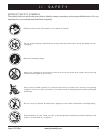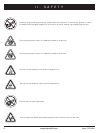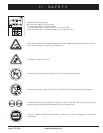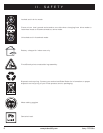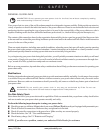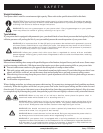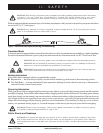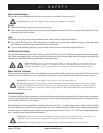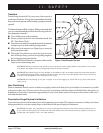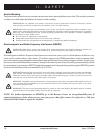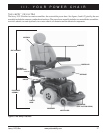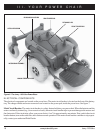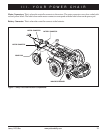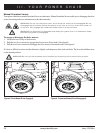
Jazzy 1103 Ultra www.pridemobility.com 13
II. SAFETY
Stairs and Escalators
Power chairs are not designed to travel up or down stairs or escalators. Always use a lift.
WARNING! Never use your power chair to negotiate steps or escalators.
Doors
! Determine if the door opens toward or away from you.
! Drive your power chair gently and slowly forward to push the door open. Or drive your power chair gently and slowly
rearward to pull the door open.
Lifts
Modern lifts have a door edge safety mechanism that, when pushed, reopens the lift door(s).
! If you are in the doorway of a lift when the door(s) begin to close, push on the rubber door edge or allow the rubber
door edge to contact the power chair and the door will reopen.
! Use care that handbags, packages or power chair accessories do not become caught in lift doors.
Lift/Elevation Products
If you will be traveling with your power chair, you may find it necessary to use a lift/elevation product to aid in transporta-
tion. Pride recommends that you closely review the instructions, specifications and safety information set forth by the
manufacturer of the lift/elevation product before using that product.
WARNING! Never sit on your power chair when it is being used in connection with any
type of lift/elevation product. Your power chair was not designed with such use in mind
and any damage or injury incurred from such use is not the responsibility of Pride.
Motor Vehicle Transport
Pride recommends that you do not remain seated in your power chair while traveling in a motor vehicle. The power chair
should be stowed in the boot of a car or in the back of a truck or van with batteries removed and properly secured.
WARNING! Do not sit on your power chair while it is in a moving vehicle.
WARNING! Always be sure your power chair and its batteries are properly secured when it is being
transported. Batteries should be secured in an upright position and protective caps should be
installed on the battery terminals. Batteries should not be transported with any flammable or
combustible items.
Positioning Belts
Your authorised Pride Dealer, therapist(s) and other healthcare professionals are responsible for determining your require-
ment for a positioning belt in order to operate your power chair safely. Typically, the positioning belt is not designed for use
as a restraining device in a motor vehicle.
Positioning belts should be installed as detailed in this manual. See V. “Comfort Adjustments.” Once installed, the belt
should be placed across the pelvis as determined by the user’s healthcare dealer. Anchor points of the positioning belts
should be located so that a projected side-view angle of the pelvis is between 30°–75° of horizontal depending on the
user’s weight, posture and seat cushion thickness.
WARNING! If you require a positioning belt to safely operate your power chair, make sure it is
fastened securely in order to reduce the possibility of a fall from the power chair.
WARNING! The positioning belt is not designed for use as a seat belt in a motor vehicle.



